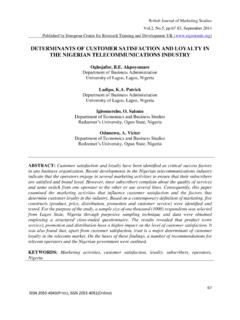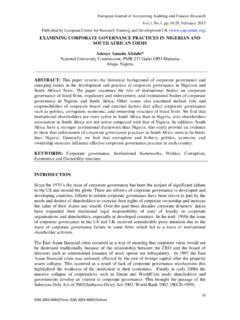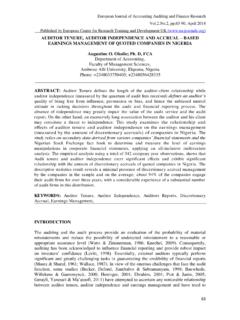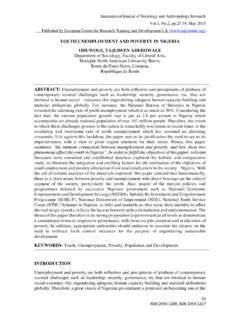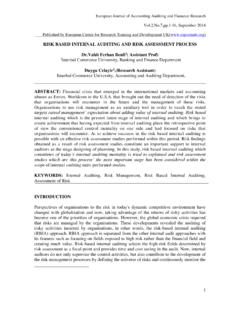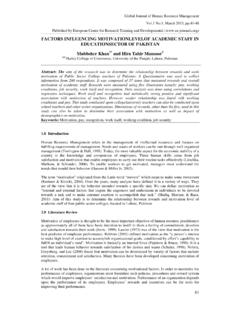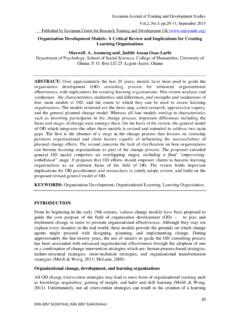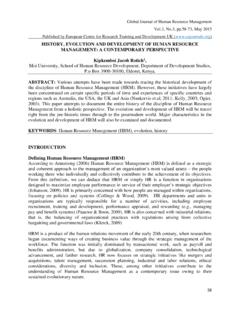Transcription of MARKETING STRATEGIES AND THE …
1 british Journal of MARKETING Studies , , , August 2016 ___Published by European Centre for Research Training and Development UK ( ) 51 ISSN 2055-0111(Print), ISSN 2055-012X(Online) MARKETING STRATEGIES AND THE PERFORMANCE OF SMALL AND MEDIUM ENTERPRISES IN AKWA IBOM STATE, NIGERIA Ebitu, Ezekiel Tom, Department of MARKETING , University of Calabar, Nigeria. ABSTRACT: The study examined the impact of three MARKETING STRATEGIES (product quality, MARKETING communication and relationship MARKETING ) on the performance of selected Small and Medium Scale Enterprises in Akwa Ibom State, Nigeria. The study was motivated by the fact that SMEs in Akwa Ibom State find themselves in a competitive environment and may not know which MARKETING strategy is effective in improving their business performances.
2 The study adopted the survey method. 240 questionnaires were issued to SMEs in the three senatorial districts of the State. This formed the sample of the study. The data obtained was analysed using Pearson Product Moment correlation analysis which was computed electronically by the use of Statistical Package for Social Science (SPSS) version 21. The study revealed that there is a significant impact of product quality strategy and relationship MARKETING strategy on the profitability and increased market share of SMEs in Akwa Ibom State. The study recommends that SMEs should invest so much in product quality rather than in advertisement as this would enhance the firm s profitability.
3 Also, the customers should be valued and treated as kings as cordial relationship between firm and customers results in the increase of the organizations market base. KEYWORDS: Small Medium Enterprises, MARKETING STRATEGIES , Performance, Relationship MARKETING , Product Quality, MARKETING Communications. INTRODUCTION Strategy is the way, method, technique or plan which an individual or organisation intends to exploit in achieving success in the marketplace or the society. Gleuck (1984) as cited in Achumba (2000:2) defines strategy as a unified, comprehensive and integrated plan relating the strategic advantage of the firm to the challenges of the environment. He added that organizations that desire not only to survive but also to improve their MARKETING effectiveness and efficiency must learn how to create and improve sound MARKETING strategy.
4 MARKETING strategy has become an important tool globally for any organization to remain in competitive market environment and wax stronger. MARKETING strategy is a vital prerequisite of Industry's ability to strengthen its market share and minimize the impact of the competition (Adewale, Adesola, & Oyewale, 2013). Owomoyela, Oyeniyi, and Ola, (2013) also see MARKETING strategy as way of providing quality product that satisfies customer needs, offering affordable price and engaging in wider distribution and back it up with effective promotion strategy. (Adewale et al, 2013). MARKETING strategy draws its strength from the overall corporate strategy. It may be defined as those MARKETING programmes and tactics designed to achieve the objectives of an organization.
5 A MARKETING strategy outlines the strategic direction and tactical plans that MARKETING teams must implement to support the company s overall objectives (Ebitu, 2015: 278). MARKETING british Journal of MARKETING Studies , , , August 2016 ___Published by European Centre for Research Training and Development UK ( ) 52 ISSN 2055-0111(Print), ISSN 2055-012X(Online) strategy articulates the best uses of a business resources and tactics to achieve its MARKETING objectives. It states which opportunities are to be pursued by an organization, indicates the specific markets towards which activities are to be targeted, and identifies the types of competitive advantage that are to be developed and exploited (Weitz & Weasley, 1988 in Dibb, Simkin, Pride & Ferrel, 2006: 37) SMEs in Akwa Ibom State find themselves in a competitive environment both locally and globally, hence effective MARKETING STRATEGIES are required to improve the business performances of the SMEs.
6 This paper examines three MARKETING STRATEGIES (product quality, MARKETING communication and relationship MARKETING ) and their impact on performance of SMEs in Akwa Ibom State. LITERATURE REVIEW Definitions of micro, small and medium-size enterprises (MSMEs) vary from different bodies, organizations and institutions in Nigeria. This confirms that there is no specific and generally accepted definitions of micro, small and medium-sized enterprises. An SME according to the Central Bank of Nigeria is one whose capital employed excluding land is between 1 million and 150 million and employs not more than 500 persons. The National Policy on Micro, Small and Medium Scale Enterprises defines SMEs with respect to the backdrop of number of persons employed and assets possessed.
7 The National Council on Industry defined Micro, Small and Medium Enterprises (MSMEs) as follows: Micro/Cottage Industry: Industry with asset base of not more than million excluding cost of land, but including working capital and a staff strength of not more than 10. Small Scale Industry: Industry with asset base of more than million but in excess of 50 million excluding cost of land, but including working capital and/or a staff strength from 11 to 100. Medium Scale Industry: Industry with asset base of more than 50 million, but not in excess of 200 million excluding cost of land but including working capital and/or a staff strength from 101 to 300. Large Scale Industry: Industry with asset base of over 200 million excluding cost of land but including working capital and/or a staff strength of more than 300.
8 Other definitions from other agencies like Small and Medium Scale Enterprises Development Agency of Nigeria (SMEDAN, 2003), Small and Medium Industries and Equity Investment Schemes (SMEIES), National Association of Small and Medium Scale Enterprises (NASME) etc. are slightly different from each other. This paper takes the position of Ebitu, Basil & Ufot, (2015) in defining SMEs as enterprises which employ less than 200 persons and possess assets which value excluding land and building is less than 300 million. SMEs are usually associated with little capital outlay, minimal fixed assets, highly localized in the area of operation, and often with unsophisticated management structure (Ebitu, Basil and Ufot, 2015).
9 Baumback (1992:4) says characteristically small businesses are those units that are actively managed by its owners, highly personalized, largely local in the area of operation, british Journal of MARKETING Studies , , , August 2016 ___Published by European Centre for Research Training and Development UK ( ) 53 ISSN 2055-0111(Print), ISSN 2055-012X(Online) of relatively small size within the industry and largely dependent on sources of capital to finance its growth. The basic distinguishing factors between small scale and large scale enterprises are as follows: i. The size within the industry is relatively small as compared to large scale enterprises. ii. The firm is owned and financed by an individual or a group of individuals.
10 Capital requirements for small scale enterprises are small and usually within the reach of indigenous entrepreneurs. iii. Small scale enterprises are either run on household basis and serve local population or cut across states and ethnic boundaries. iv. The manager/proprietor handles and supervises the financing, production, MARKETING and personnel of the enterprises. v. The manager/proprietor may not be able to raise short term capital needs of his business from the organized financial market, instead he relies heavily on personal savings or loans from friends, relations or money lenders. vi. The enterprise is generally poorly equipped as the small firm feels reluctant to accept outside help owing to prejudice or fear that information about the enterprise might reach the tax authorities or a nearby competitor.
